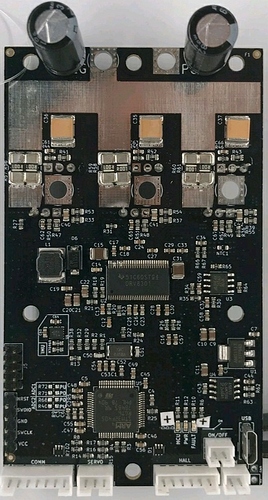I just received my DE-5000 LCR meter today and started messing around with it. My CF2s measured ~70uH on my big motor and 1.3uH on my small one. The LCR meter measured 150-160uH on the big motor and 6-7.5uH on the small one. Turning the big motor up to 150uH allows hard starts under load up to 55A. Still faults out at around 60A. Will keep playing!
wow, I had not read your thread but you have a great job here, you are doing something great for the community, you are going to make me build 10 of these when I only occupy 3 hahaha. any idea when the v1 version will be
I could split an order of 10 if you like. Are you in the U.S.?
my CFOC2 has been running really great.
I’m at 37A battery, and 70 motor. Running a heatsink with fresh air moving over it. I’ve never felt the heatsink get much over ambient.
Who’s pushing over 37A at ~ 12s-ish voltage?
Glad to hear you overcame your battery issues!
I apologize if this has already been asked, but do we know whether v1.0 will be similar cost to v0.9?
There’s one more bulk cap, a 5V TVS diode, and few more small components in the gate drive circuitry. This adds extra cost but I don’t think more than like $3USD.
Now I have a silly, and unrelated question…
It seems like the DRV is always the most delicate part on these things, but from what I gather, it’s effectively a logic device - right? I mean it doesn’t handle any real current. So if my understanding is correct, it fails from transient voltage spikes. If we used opto-isolators I would think that would protect everything but Vcc pretty much 100%. I would assume it should also be possible to protect Vcc with zeners or other magic.
I’m almost certainly missing something, but what?
The DRV does source and sink significant current when driving the MOSFETs. One could isolate the gate drive signals but it would be very roundabout and not cheap or practical.
Protecting the DRV from Vsupply is difficult since TVS diodes are hard to find at the proper working and clamp voltages needed as @Fatglottis found out.
In reality, the DRV8301 was designed for only 36V applications. We have normalized pushing this thing beyond it’s intended application with the VESC and VESC based designs. Not saying one can’t achieve 12S and sometimes even 13S operation with it but don’t be surprised to have the DRV8301 burn out under these conditions.
For more reliable >10S operation, it’s better to just go to a higher voltage gate driver (DRV8353) or design out the DRV entirely and move to gate drivers or half bridge gate drivers.
@drdrs
Regarding your red LED blinks at start up…
Under General\ Advanced tab, there is a parameter named “fault stop time”. Setting this to a value above 1700ms will cause the red LED to blink 10 times at startup.
I had mine set to 3000ms and it resulted in two sequences of 17 red blinks at start up.
Maybe this is your case as well?
the place where the pcb are assembled does not have the drv8353, or does it increase production costs a lot?
the 8353 isn’t a drop in replacement for the 8301, and would likely require rework of the DRV interface and perhaps even the entire CFOC platform.
Price wise, the 8353 and the 8301 are similar, but supporting components may cause inflation.
@Davewesh is correct here and swapping out for the DRV8353 isn’t arbitrary. I designed a whole different controller around it called the Little FOCer. It’s a more premium product that’s not geared for open hardware and DIY like the CFOC2 is. However, praise the day if/when JLCPCB supports the DRV8353 in its SMT service or even the DRV8323.
Trying to increase the operating voltage with the CFOC2 design will result in it being larger and/or more expensive. The higher the voltage rating of the components, the more they cost.
oh ya, I understand a better peak.
this vesc is more recommended for something under 12s?
I was thinking of using it in a tesla 12s5p battery but maybe I could go for an 11s6p or 10s6p, what would you recommend more?
12S is doable in the right conditions. What kind of motor and how much motor current are you looking to do?
I’m thinking in use 2 sk3 6374 192kv According to me they can only take 50a but I’m not sure
Don’t quote me on it but I ran mine at 80a with no issues
Seems like a typical esk8 rig. There are several doing this just fine with CFOC2 at 12S. Even 13S (@doomy). I would just avoid doing any high rpm with the motors unloaded.
Thanks shaman for everything you did and made this open source. It is a thing of beauty  I have produced 5 pieces to make funwheels. Still have to receive them. This is a photo from the factory to ask everything is ok before the start post soldering. The capacitors Will be bend to save some space in the height.Hopefully everything works out with the bootloader
I have produced 5 pieces to make funwheels. Still have to receive them. This is a photo from the factory to ask everything is ok before the start post soldering. The capacitors Will be bend to save some space in the height.Hopefully everything works out with the bootloader  With a fresh cashflow i will donate a small amount to you.
With a fresh cashflow i will donate a small amount to you.
Are the serious focers also an open source project?
My other controllers won’t be open source hardware… but the CFOC2 won’t be my last open source hardware design either. I like contributing to open source but at some point I would like for my designs to provide a bit of income for me
